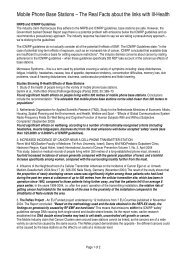West Sutherland Elver Survey
West Sutherland Elver Survey
West Sutherland Elver Survey
Create successful ePaper yourself
Turn your PDF publications into a flip-book with our unique Google optimized e-Paper software.
<strong>West</strong> <strong>Sutherland</strong> <strong>Elver</strong> <strong>Survey</strong> 2008<br />
Hydroelectric dams present a controversial problem for eel migration, as eels require eel<br />
passes to negotiate up stream and measures need to be taken to reduce silver eel mortality<br />
through turbines during down stream migration. Eel mortality through turbines was<br />
estimated at 16-26% on the River Meuse (Winter et al. 2006) but is strongly influenced by<br />
turbine design and eel length. Eels have been of minimal concern in conjunction with<br />
hydroelectric systems in Scotland and no measures have been taken to facilitate silver eel<br />
migrations, although SEPA, under the Water Framework Directive, are responsible for<br />
ensuring the connectivity of river habitats. For hydroelectric dams, up stream eel passes<br />
would be easy to install but down stream would require retro-fitting intake protection<br />
facilities at considerable costs. Selective spillways open during migration periods could be<br />
installed with non-mechanical infrasound barriers around turbines (Sand et al, 2000) if more<br />
information was known about the migration timing of silver eels in Scotland.<br />
SUB-LEATHAL POISONING<br />
Though pollution is certainly extremely low in <strong>Sutherland</strong>, eel recruitment in <strong>Sutherland</strong> may<br />
suffer from pollution affecting eels in the rest of Europe. The contribution of various<br />
pollutants on eel mortality has been widely studied, and the quantity of bioaccumulated<br />
contaminants during the inland growth stage probably has a key influence on breeding<br />
success, larval survival and migration success of glass eels and elvers. Due to the long<br />
lifecycle, benthic habit, diverse feeding at various levels in the food web and long term fat<br />
storage, eels are efficient bioaccumulators of substantial body burdens of a variety of heavy<br />
metals and persistent organic pollutants. Due to this, the use of the European eel as a<br />
species for pollution biomonitoring was initially proposed more than 20 years ago.<br />
There is no proof of significant mortality due to persistent pollutants (except in major but<br />
isolated accidents) and several studies have shown that a number of pollutants such as<br />
organochlorine compounds have decreased significantly during the past 20 years. The<br />
observed concentrations are most often below acute toxicity levels for eels, and it is<br />
suggested that contamination, in particular by PCBs is not responsible for the decline of<br />
European eel. However, recent studies have found quantities of Brominated flame<br />
retardants and PCBs (even though they were banned 20 yeas ago) in samples of eels across<br />
Europe below acute toxicity level for eels, though unsuitable for human consumption<br />
(Santillo, D., et al., 2005). Sub-lethal concentrations have many consequences on the<br />
physiology of eels which appear to be much more sensitive to pollutants than many other<br />
species. Though the effect of sub-lethal doses of contaminants on reproductive success of<br />
eels is poorly known, a wide range of contaminants such as PCBs, pesticides, heavy metals<br />
and plastifiers disturb reproductive hormonal cycles in fishes and therefore, reduce the<br />
breeding success. Moreover, brominated flame retardants (which mimic thyroxin and affect<br />
neurobehavioral development) and PCBs (which mimics estrogens, and impairs egg quality<br />
and embryonic development) are highly fat soluble accumulating in eels as they build up fat<br />
reserves to 1/3 of body weight over many years. Thus when fat reserves are mobilised for<br />
energy during migration to the Sargasso Sea pollutants are released into the eels blood<br />
stream. Once released into the eel they may cause acute toxicity or sub-lethal levels may<br />
cause the eel to change sex or mature too early, reducing the hydro-dynamics of eels such<br />
that they may not reach the Sargasso.<br />
27 <strong>West</strong> <strong>Sutherland</strong> Fisheries Trust











